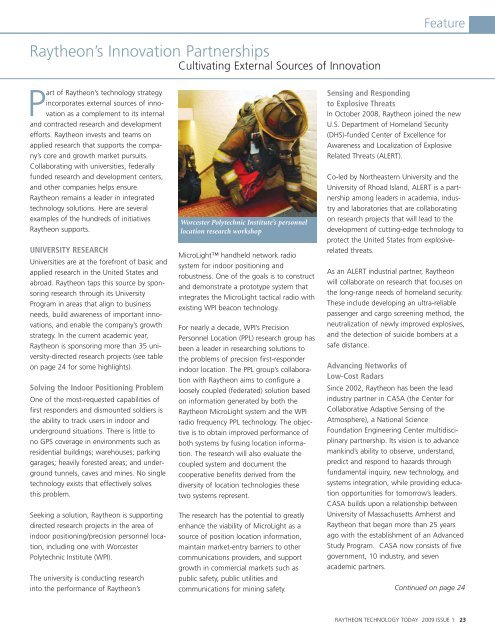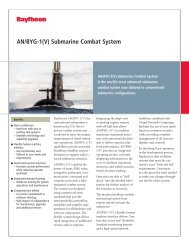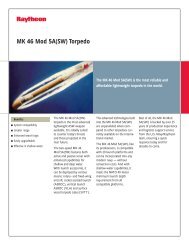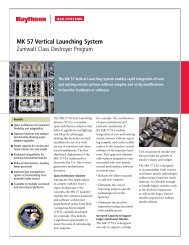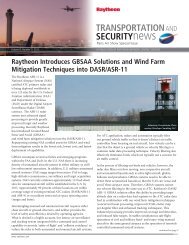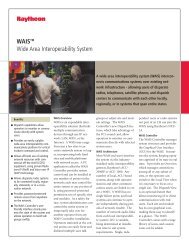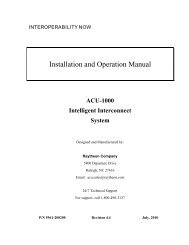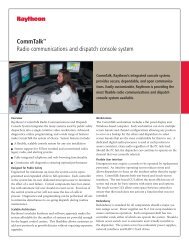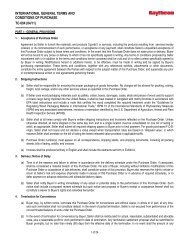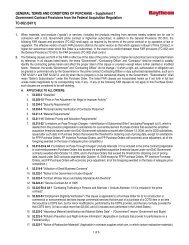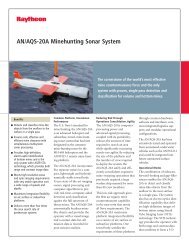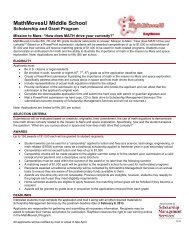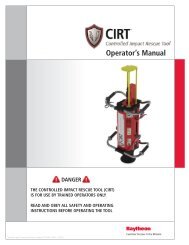Tech_Issue 1 2009_0127_Final:TechToday_012709 ... - Raytheon
Tech_Issue 1 2009_0127_Final:TechToday_012709 ... - Raytheon
Tech_Issue 1 2009_0127_Final:TechToday_012709 ... - Raytheon
You also want an ePaper? Increase the reach of your titles
YUMPU automatically turns print PDFs into web optimized ePapers that Google loves.
<strong>Raytheon</strong>’s Innovation Partnerships<br />
Cultivating External Sources of Innovation<br />
Part of <strong>Raytheon</strong>’s technology strategy<br />
incorporates external sources of innovation<br />
as a complement to its internal<br />
and contracted research and development<br />
efforts. <strong>Raytheon</strong> invests and teams on<br />
applied research that supports the company’s<br />
core and growth market pursuits.<br />
Collaborating with universities, federally<br />
funded research and development centers,<br />
and other companies helps ensure<br />
<strong>Raytheon</strong> remains a leader in integrated<br />
technology solutions. Here are several<br />
examples of the hundreds of initiatives<br />
<strong>Raytheon</strong> supports.<br />
UNIVERSITY RESEARCH<br />
Universities are at the forefront of basic and<br />
applied research in the United States and<br />
abroad. <strong>Raytheon</strong> taps this source by sponsoring<br />
research through its University<br />
Program in areas that align to business<br />
needs, build awareness of important innovations,<br />
and enable the company’s growth<br />
strategy. In the current academic year,<br />
<strong>Raytheon</strong> is sponsoring more than 35 university-directed<br />
research projects (see table<br />
on page 24 for some highlights).<br />
Solving the Indoor Positioning Problem<br />
One of the most-requested capabilities of<br />
first responders and dismounted soldiers is<br />
the ability to track users in indoor and<br />
underground situations. There is little to<br />
no GPS coverage in environments such as<br />
residential buildings; warehouses; parking<br />
garages; heavily forested areas; and underground<br />
tunnels, caves and mines. No single<br />
technology exists that effectively solves<br />
this problem.<br />
Seeking a solution, <strong>Raytheon</strong> is supporting<br />
directed research projects in the area of<br />
indoor positioning/precision personnel location,<br />
including one with Worcester<br />
Polytechnic Institute (WPI).<br />
The university is conducting research<br />
into the performance of <strong>Raytheon</strong>’s<br />
Worcester Polytechnic Institute’s personnel<br />
location research workshop<br />
MicroLight handheld network radio<br />
system for indoor positioning and<br />
robustness. One of the goals is to construct<br />
and demonstrate a prototype system that<br />
integrates the MicroLight tactical radio with<br />
existing WPI beacon technology.<br />
For nearly a decade, WPI’s Precision<br />
Personnel Location (PPL) research group has<br />
been a leader in researching solutions to<br />
the problems of precision first-responder<br />
indoor location. The PPL group’s collaboration<br />
with <strong>Raytheon</strong> aims to configure a<br />
loosely coupled (federated) solution based<br />
on information generated by both the<br />
<strong>Raytheon</strong> MicroLight system and the WPI<br />
radio frequency PPL technology. The objective<br />
is to obtain improved performance of<br />
both systems by fusing location information.<br />
The research will also evaluate the<br />
coupled system and document the<br />
cooperative benefits derived from the<br />
diversity of location technologies these<br />
two systems represent.<br />
The research has the potential to greatly<br />
enhance the viability of MicroLight as a<br />
source of position location information,<br />
maintain market-entry barriers to other<br />
communications providers, and support<br />
growth in commercial markets such as<br />
public safety, public utilities and<br />
communications for mining safety.<br />
Feature<br />
Sensing and Responding<br />
to Explosive Threats<br />
In October 2008, <strong>Raytheon</strong> joined the new<br />
U.S. Department of Homeland Security<br />
(DHS)-funded Center of Excellence for<br />
Awareness and Localization of Explosive<br />
Related Threats (ALERT).<br />
Co-led by Northeastern University and the<br />
University of Rhoad Island, ALERT is a partnership<br />
among leaders in academia, industry<br />
and laboratories that are collaborating<br />
on research projects that will lead to the<br />
development of cutting-edge technology to<br />
protect the United States from explosiverelated<br />
threats.<br />
As an ALERT industrial partner, <strong>Raytheon</strong><br />
will collaborate on research that focuses on<br />
the long-range needs of homeland security.<br />
These include developing an ultra-reliable<br />
passenger and cargo screening method, the<br />
neutralization of newly improved explosives,<br />
and the detection of suicide bombers at a<br />
safe distance.<br />
Advancing Networks of<br />
Low-Cost Radars<br />
Since 2002, <strong>Raytheon</strong> has been the lead<br />
industry partner in CASA (the Center for<br />
Collaborative Adaptive Sensing of the<br />
Atmosphere), a National Science<br />
Foundation Engineering Center multidisciplinary<br />
partnership. Its vision is to advance<br />
mankind’s ability to observe, understand,<br />
predict and respond to hazards through<br />
fundamental inquiry, new technology, and<br />
systems integration, while providing education<br />
opportunities for tomorrow’s leaders.<br />
CASA builds upon a relationship between<br />
University of Massachusetts Amherst and<br />
<strong>Raytheon</strong> that began more than 25 years<br />
ago with the establishment of an Advanced<br />
Study Program. CASA now consists of five<br />
government, 10 industry, and seven<br />
academic partners.<br />
Continued on page 24<br />
RAYTHEON TECHNOLOGY TODAY <strong>2009</strong> ISSUE 1 23


